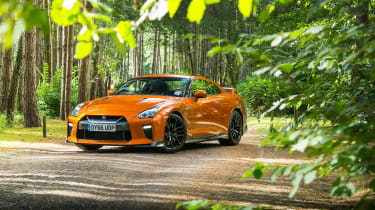Nissan GT-R (R35, 2009 - 2022) review – ride and handling
The GT-R has always been – and is still – capable of seeing off virtually any other car on the road. The 2017 car's revisions brought notable improvements to the ride, and R mode is no longer unusable when the going gets bumpy.
The standard GT-R was definitely more of a GT after its 2017 update, with greater habitability in everyday use on the road. It certainly still accelerated like a GT-R, though, and if anything its engine felt slightly stronger at the top of the rev-range, staying keen until all the rev-limiter lights were illuminated. Overtakes have rarely felt so easy.
However, there was definitely less aggression in the way that the GT-R handled. It was slightly mellower on turn in, and some of the assertive agility that we are used to has been removed. Earlier edgier cars lunge toward the inside line and some of that excitement has been rounded off. There was still more than enough power to get the tail swinging wide on the exit of a corner, but unless you trail braked, it doesn’t feel like you will unsettle the rear with turn-in alone. It still demolished a B-road in alarming fashion, leaning on incredible grip and leaving most other cars for dead in the process, but a bit of the instant adjustability felt like it had been removed. It felt more secure and planted, but inevitably a little less entertaining.
One notable indication that the 2017 GT-R shifted its focus is that it felt like the R setting was necessary when driving really hard on the road. Previously that would have been unthinkable, with the normal setting being plenty firm enough and the R setting usable only on a track. However, if you left the Bilstein dampers of the later car in Normal, the car could feel a little floaty when pushing on through compressions and over bumps.
It was still freakishly quick on both road and track, and still felt distinctively GT-R, but with a lift in day-to-day usability. And this made complete sense really, because of the extended model range of three that arrived with the 2017 update. In addition to the base car, there was also a Track Edition (which restored some of the chassis’ keen, edgy agility) and then the full-on Nismo. The GT-R Nismo was certainly a different prospect. It is a hardcore track car that still somehow works on the road.
> Read our review of the Nissan GT-R Nismo
We’ve spent plenty of time with the Nismo and it remains one of the most astonishingly brilliant feats of engineering achieved this decade. It grips, turns and stops like almost nothing else, but its greatest talent is the level of engagement it portrays along with it. The hydraulic steering delivered a constant stream of feedback about how much grip the front tyres have. While the throttle, thanks to the engine’s power and response, gave you the ability to adjust the car’s angle mid-corner.
Slacken off the dampers and there’s a level of fluidity to the way it attacked the road that felt impossible considering how well contained the body was. With such big speeds so easily accessible, the Nismo’s fascinating ability of feeling 500kg lighter than its kerb weight made it a car you don’t just drive fast, but can start to take liberties with, pushing beyond its staggeringly high limits with unnatural ease.



